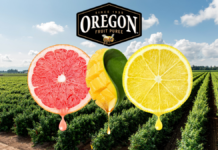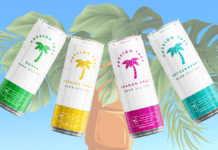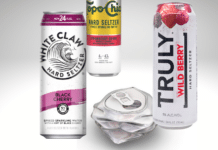In a recent interview with Hard Seltzer News, Post Meridiem Spirits co-founder Andrew Rodbell talked about the company’s origins, the early success of a new brand of RTDs, riding the coattails of the hard seltzer wave, and more
HSN: Can you talk a little bit about your background working at Coca-Cola and how Post Meridiem started?
AR: I’ve had a very traditional marketing career, including a long stint at the Coca-Cola company where I worked in brand management and new product development. I was lucky to be around and learn from a lot of talented people including entrepreneurs. I always had an entrepreneurial itch though and when my business partner — who’s an old friend — approached me about working together, it was an easy decision to venture out on my own. I’ll say the corporate America experience certainly helped shape how I built my own company and developed my idea and how I came to market. Just a couple quick anecdotes on that — for example, I learned no matter how functional a beverage is, taste is king. If it doesn’t taste good, consumers won’t drink it. No matter how much you love your idea, you still have to pilot and start small and make sure consumers actually appreciate it and there’s a market for it…Then, one of the big ones I learned was just, again, be differentiated. If you’re not unique, don’t go out at all because it’s so hard to get the consumer share…I have a dozen other life lessons and things like that, but I’ll keep it to those few. [Don’t] get me wrong — I’ll just say this: I’ve learned more in the last few years working at Post Meridiem than I did in 20 plus years in corporate America.
HSN: What were some main points you took into account/your ultimate vision when beginning this venture?
AR: Inspiration came at a moment of frustration. My business partner, Charles, and I were at a concert, and we craved a mai tai, and it inspired a deep dive into ready to drinks. So, I could spend all day on due diligence that I ran evaluating the ready to drink category four years ago — and I won’t bore you or your audience with that — but there were a couple trends and points that I would point out that kind of helped inspire me. One, I was watching the growth of craft beer, the growth of canned wine and the rise of hard seltzers. [I’ll] just say this real fast — even I, who is very optimistic, did not project the exponential growth in this category. It’s been insane. I was also watching the rise of premium brands, and then even seeing the rise of health and wellness kind of seep its way even into the alcohol industry. But, the key statistic that really grabbed me was the fact that ready to drink beverages in Asia and Europe were about three or four times the per caps that they were in the U.S. and that just kinda showed me that there’s a lot of growth potential for here in the U.S. that’s unmapped. So, that helped build my confidence to do this. But, to answer your question directly, you know, the one driving principle that we worked around was if we can’t make an authentic cocktail, we won’t do it at all. We were committed then and there to authenticity — meaning real ingredients, nothing fake, nothing engineered, at the right proportions and at the proper strength. [What] it took to get that done was we ended up partnering up with a mixologist to help us source the best ingredients and build the right balance. We worked with food scientists who ensured the viability and taste of our cocktails. We worked with packaging engineers to ensure that our real ingredients were protected. And, I guess, to cut it all off I’ll say we’re proud to have solved each and every one of those challenges allowing us to fulfill our original vision, which was to be true to our commitment to authenticity. So, [sic] we’re really happy that the drinks came out the way they did.
HSN: You kind of touched on this before, with the rise of health and wellness, but what’s the primary demographic you would say you market to?
AR: It’s funny when you talk about demographics I’ll say this — as a corporate marketer in corporate America that had access to amazing data…As the founder of a start-up in the alcohol space, I don’t. So, I’m learning to fly a little bit blind, but that being said, I did certainly have a target consumer in mind when I designed this product…I could talk about health and wellness, and transparency and convenience are really critical to a younger generation of consumers and I certainly had in mind [who] I thought the demographic would be. But, you know, I am paying close attention to who’s actually buying this and why and for good or for bad, there seems to be a wide net of consumers. Whether it’s a young drinker looking for a strong drink, or a mature drinker looking for convenience, [sic] the gender balance has actually surprised me. It’s very even and great, and the appeal of cocktails just clearly spans all demographics…The good news, bad news, again, is that’s a marketing problem, but it’s also inspiring too because the cocktail resurgence is for all types. But, just to be direct and answer your question, [sic] we were certainly thinking of, you know, 25 to 40-year-olds, higher household income, all those kinds of statistics. But, the reality is it’s a millennial mindset. The mindset of just wanting high quality and easy convenience.
HSN: Yeah, that’s interesting. I’ve heard that phrase “millennial mindset” from a couple of people that I’ve talked to who are moving into the RTD category. How did you settle on your current line up of flavors? I know you talked about the mai tai, so clearly you’re a fan of that. [Are] there any new ones in the pipeline?
AR: Yes, that’s a good question. We wanted to make cocktails that people recognized. Familiarity is a good thing when consumers are at the point of purchase. So, that’s why the name of the cocktail is the most prominent feature on our label. It’s also why we list the ingredients right on the front of label two. You know, we’re not reinventing the wheel. We’re just making recognizable cocktails simply and at a new level of quality for the RTD category…Our line up includes very recognized and widely consumed cocktails. We have a margarita, we have an old fashioned, we have a daiquiri, we have a gimlet, and, of course — as you referenced — the mai tai…We do have a pipeline of new ideas, but we’ll always keep with a recognizable principle. You know, we want to make sure people are, again, familiar with these drinks. But, there are some handcuffs given the fact that we’re also fully dedicated to only using real ingredients. So, there are some ingredients that have too short a shelf life, and [sic] we would never use an engineered substitute, [sic] therefore some cocktails we love are simply off the table [sic].
HSN: We’ve seen people are often reaching for lower alc RTD options. How do you think spirit-based (especially real cocktail-focused) RTDs fit in with some of these other types of RTDs such as hard seltzer which are you know as low at 3.5%?
AR: Good question. I’ll start off by saying that spirit-based full-strength cocktails like ours and low alcohol ready to drinks like a hard seltzer are for different occasions. That being said, I think there’s a pattern to how people discover new categories and mature as drinkers. So, I see hard seltzers are clearly cannibalizing beer, meaning consumers are leaving beer to go to hard seltzers. Then, I see them kind of moving from malt-based hard seltzers to more authentic spirit-based hard seltzers. [sic] I think it’s an easy jump to go from there to say the consumers who enjoy spirit-based hard seltzers will likely enjoy a spirit-based cocktail, and Post Meridiem will be there to catch those consumers who are on that journey…Another point I would make about health consciousness — which you brought up before — is that there’s almost two forms of health consciousness. One is calorie avoidance, meaning people are looking for lower calories and that’s the driving factor as they move away from beer. The other is chemical avoidance, so people who are moving away from artificial ingredients to genuine ingredients like what we do at Post Meridiem. So, I think that [if] consumers are seeking transparency and authenticity and naturalness, that’s kind of why we exist. So, you know, [sic] pick your poison — calories or chemicals.
HSN: Has the hard seltzer boom impacted the way you market or create your beverages? You’ve already touched on this a bit, but has it helped generate interest in your products have you found?
AR: Yeah, I’m happy to ride the coattails of the hard seltzers. It’ll bring more people into the canned and ready to drink category in general…Again, as you said, I just mentioned the fact that I think people are on a journey from beer to spirits and we’d love to be part of that. The catch is that everyone seems to be getting into ready to drinks lately. You have…massive beer brands are doing it, hyper-local beer brands are doing it, even my old company Coca-Cola [is] launching Topo Chico Hard Seltzer, which blows my mind for a couple of reasons…But, you know, I’m just glad we’re differentiated with full-strength authentic ingredient cocktails even though we have a few fast followers, and I do expect more. I feel like this is just an emerging category, and I think that, again, just the attention this whole category has been getting is good for everybody.
HSN: Do you think your products (and other RTD cocktails) will gain traction at on-premise locations after we go through the process of reopening things after the COVID shut down? Or is the primary target still off-premise?
AR: I’m very optimistic about on-premise ready to drinks. I used to go to hotel pitches and say you should want ready to drink, and we’re best in class. Now, hotels are calling up our distributors asking for ready to drinks, and all I have to do is step in and say we’re best in class. It’s a much easier sell. But, ready to drinks offer many benefits for on-premise locations. Whether it’s — especially in this modern world — a low touch alternative, you know, quicker speed of service, easy inventory management, offering the end consumer a big variety…I think [sic] we do have a lot of room to grow in the on-premise world, and I’m optimistic for more. So, yeah, I think to answer your question directly — very optimistic about the on-premise world, and while off-premise is still our bread and butter, we’re excited about new ventures and new partnerships.
HSN: Yeah, I can see that maybe some restaurants that don’t have a full bar or the ability to have a full bar might take on some cans that they can just really easily open and pour for customers so they can do something more than just wine or beer. Although, I know there’s a different liquor license for that. So, I wanted to wrap up the interview by asking you if there’s anything else you want to talk about — just free reign to say whatever you like.
AR: Well, yeah I appreciate that. Yeah, I’d have to think about that for a second. I’ll say this — [sic] we’re really excited that Post Meridiem, which launched in Georgia in May of 2019, we’ve quickly expanded in South Carolina, Alabama and now Tennessee. We’re really excited about the future. We would definitely consider ourselves a strong southern brand, but we’d like to see our footprint and will see our footprint expand rapidly beyond that in the near term…We’re also just very excited about the category in general and how much attention it’s been getting, and you know the stats as well as I do, but the rapid growth of this, I think, it’s not just a temporary. I think this isn’t just a COVID blip. I think these trends were happening before and I think COVID is just accelerating these trends. So, I’m optimistic for the future and really excited to be able to join you and chat a little bit about it.
- Podcast: New Realm’s Mitch Steele Talks Hard Seltzer - March 8, 2021
- Big Brands Bring Awareness with Publicity — in the Market or in the Courts - February 27, 2021
- Naked Seltzer Betters the Home Bar - February 26, 2021















